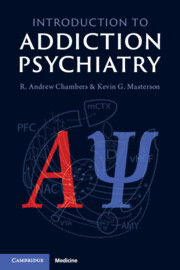Book contents
- Introduction to Addiction Psychiatry
- Introduction to Addiction Psychiatry
- Copyright page
- Contents
- Preface
- 1 Population Impact: Epidemiology
- 2 Specific Symptom Sets: Clinical Phenomenology
- 3 A Disorder of Anatomical Structure and Function: Neurobiology
- 4 Biological Risk Amplification: Disease Vulnerability
- 5 Diagnosis and Treatment: Disease Tracking, Reduction, and Remission
- Index
- References
3 - A Disorder of Anatomical Structure and Function: Neurobiology
Published online by Cambridge University Press: 03 April 2025
- Introduction to Addiction Psychiatry
- Introduction to Addiction Psychiatry
- Copyright page
- Contents
- Preface
- 1 Population Impact: Epidemiology
- 2 Specific Symptom Sets: Clinical Phenomenology
- 3 A Disorder of Anatomical Structure and Function: Neurobiology
- 4 Biological Risk Amplification: Disease Vulnerability
- 5 Diagnosis and Treatment: Disease Tracking, Reduction, and Remission
- Index
- References
Summary
The front door to addiction pathophysiology is through the nucleus accumbens (NAC) (aka, ventral striatum) – the brain’s primary neural network for representing, storing, and modifying motivational information. NAC motivational codes are informed and altered by converging axonal inputs from prefrontal cortex (PFC), hippocampal formation (HCF), and amygdala (AMY) that import cognitive and emotional information carried by glutamate (GLU) neurotransmission. Relaying motivational codes from NAC into the caudate-putamen (CA-PU; aka, dorsal striatum) influences the prioritization, sequencing, automaticity, and execution of complex, goal-directed motor programs. Four classes of stimuli increase dopamine (DA) neurotransmitter release into the NAC – events that are (1) rewarding, (2) unexpected, (3) stressful/painful, and (4) addictive drugs. The three classes of natural salient events promote DA discharge into the NAC to optimize flow of motivational information while operating as a learning signal for the creation and modification of new motivational codes and motor program sequences. In addiction pathogenesis, repeated drug delivery exploits the DA learning signal, causing abnormal changes in neuronal DNA expression, phenotypes, and axodendritic connections within the NAC network. This change in connectivity alters motivational codes managed and stored by the NAC network, so that motivated behavior driving drug use is involuntarily prioritized over other healthy motivations.
Keywords
- Type
- Chapter
- Information
- Introduction to Addiction Psychiatry , pp. 79 - 116Publisher: Cambridge University PressPrint publication year: 2025

